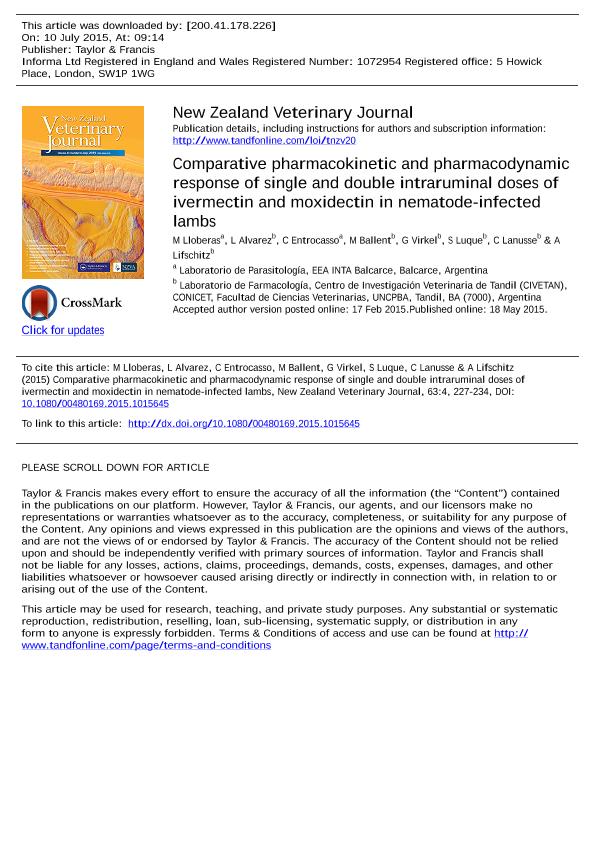Artículo
Comparative pharmacokinetic and pharmacodynamic response of single and double intraruminal doses of ivermectin and moxidectin in nematode-infected lambs
Lloberas, Maria Mercedes; Alvarez, Luis Ignacio ; Entrocasso, Carlos Miguel; Ballent, Mariana
; Entrocasso, Carlos Miguel; Ballent, Mariana ; Virkel, Guillermo Leon
; Virkel, Guillermo Leon ; Luque, Sonia Elisabet
; Luque, Sonia Elisabet ; Lanusse, Carlos Edmundo
; Lanusse, Carlos Edmundo ; Lifschitz, Adrian Luis
; Lifschitz, Adrian Luis
 ; Entrocasso, Carlos Miguel; Ballent, Mariana
; Entrocasso, Carlos Miguel; Ballent, Mariana ; Virkel, Guillermo Leon
; Virkel, Guillermo Leon ; Luque, Sonia Elisabet
; Luque, Sonia Elisabet ; Lanusse, Carlos Edmundo
; Lanusse, Carlos Edmundo ; Lifschitz, Adrian Luis
; Lifschitz, Adrian Luis
Fecha de publicación:
02/2015
Editorial:
New Zealand Veterinary Association
Revista:
New Zealand Veterinary Journal
ISSN:
0048-0169
e-ISSN:
1176-0710
Idioma:
Inglés
Tipo de recurso:
Artículo publicado
Clasificación temática:
Resumen
AIMS: To compare the pharmacokinetics, distribution and efficacy (pharmacodynamic response) of intraruminal ivermectin (IVM) and moxidectin (MXD) administered at 0.2 and 0.4 mg/kg to naturally nematode-infected lambs, and to determine the ex vivo accumulation of these anthelmintics by Haemonchus contortus. METHODS: Romney Marsh lambs, naturally infected with IVM-resistant H. contortus, were allocated to treatment groups based on faecal nematode egg counts. They received 0.2 or 0.4 mg/kg IVM or MXD (n=10 per group), or no treatment (Control; n=6), on Day 0. Samples from four animals from each treatment group, including abomasal parasites, were obtained on Day 1. Plasma samples were also collected from Day 0 to 14, and a faecal egg count reduction test (FECRT) and a controlled efficacy trial were carried out on Day 14. Concentrations of IVM and MXD in plasma, in abomasal and intestinal tissues and in H. contortus were evaluated by high-performance liquid chromatography. Additionally, the ex vivo drug accumulation of IVM and MXD by H. contortus was determined. RESULTS: Peak plasma concentrations and the area under the concentration vs. time curve for both IVM and MXD were higher for 0.4 than 0.2 mg/kg treatments (p<0.05), but there were no differences for other parameters. Concentrations of IVM and MXD in the gastrointestinal target tissues and in H. contortus were higher compared to those measured in plasma. Concentrations of both drugs in H. contortus were correlated with those observed in the abomasal content (r=0.86; p<0.0001). The exposure of H. contortus to IVM and MXD was related to the administered dose. Mean FECRT and efficacy for removal of adult H. contortus was 0% for IVM at 0.2 and 0.4 mg/kg. For MXD, FECRT were >95% for both treatments, and efficacy against H. contortus was 85.1% and 98.1% for 0.2 and 0.4 mg/kg, respectively. The ex vivo accumulation of IVM and MXD in H. contortus was directly related to the drug concentration present in the environment and was influenced by the duration of exposure. CONCLUSION: Administration of IVM and MXD at 0.4 compared with 0.2 mg/kg accounted for enhanced drug exposure in the target tissues, as well as higher drug concentrations within resistant nematodes. The current work is a further contribution to the evaluation of the relationship between drug efficacy and basic pharmacological issues in the presence of resistant parasite populations.
Archivos asociados
Licencia
Identificadores
Colecciones
Articulos(CIVETAN)
Articulos de CENTRO DE INVESTIGACION VETERINARIA DE TANDIL
Articulos de CENTRO DE INVESTIGACION VETERINARIA DE TANDIL
Citación
Lloberas, Maria Mercedes; Alvarez, Luis Ignacio; Entrocasso, Carlos Miguel; Ballent, Mariana; Virkel, Guillermo Leon; et al.; Comparative pharmacokinetic and pharmacodynamic response of single and double intraruminal doses of ivermectin and moxidectin in nematode-infected lambs; New Zealand Veterinary Association; New Zealand Veterinary Journal; 63; 4; 2-2015; 227-234
Compartir
Altmétricas



